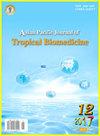多酚类化合物的体外抗黑色素瘤作用
IF 1.7
4区 医学
Q3 TROPICAL MEDICINE
引用次数: 1
摘要
目的:评价酚酸(咖啡酸、阿魏酸和香豆素酸)和黄酮(木犀草素和芹菜素)对小鼠黑色素瘤B16-F10细胞增殖和黑色素生成的影响。方法:采用MTT法检测培养24小时和48小时后细胞增殖情况。通过流式细胞术分析这些测试化合物对细胞周期进展的影响。此外,用分光光度法在475nm处测定了黑色素含量和酪氨酸酶活性。结果:木犀草素和芹菜素对B16-F10细胞具有显著的抗增殖活性,而咖啡酸、阿魏酸和香豆素酸在培养24和48小时后具有轻微的抑制作用。所测试的化合物通过随后G1期的降低和G1/S期或G2/M期的阻滞周期进程来干扰B16-F10的细胞周期进程。此外,芹菜素引起B16-F10细胞黑色素含量的增加。相反,木犀草素、咖啡酸、阿魏酸和香豆素酸通过抑制酪氨酸酶活性来诱导B16-F10细胞黑色素含量的降低。结论:这些活性多酚可作为皮肤增白剂或天然鞣剂用于治疗皮肤色素沉着障碍。本文章由计算机程序翻译,如有差异,请以英文原文为准。
In vitro anti-melanoma effect of polyphenolic compounds
Objective: To evaluate the effects of phenolic acids (caffeic, ferulic, and coumaric acids) and flavones (luteolin and apigenin) on the proliferation and melanogenesis in murine melanoma B16-F10 cells. Methods: Cell proliferation was determined after 24 and 48 hours of incubation using MTT assay. The effects of these tested compounds on cell cycle progression were analyzed by flow cytometry. Moreover, the melanin content and tyrosinase activity were measured spectrophotometrically at 475 nm. Results: Luteolin and apigenin exhibited significant anti-proliferative activity against B16-F10 cells, while caffeic, ferulic, and coumaric acids induced slight inhibition after 24 and 48 hours of incubation. The tested compounds disturbed cell cycle progression of B16-F10, by a subsequent decrease in G1 and arrested cycle progression in either G1/S or G2/M phase. Furthermore, apigenin provoked an increase in melanin content of B16-F10 cells. In contrast, luteolin, caffeic, ferulic and coumaric acids induced a decrease in melanin content of B16-F10 cells by inhibiting tyrosinase activity. Conclusions: These active polyphenols may be used as skin whitening agents or natural tanning agents to treat skin pigmentation disorders.
求助全文
通过发布文献求助,成功后即可免费获取论文全文。
去求助
来源期刊

Asian Pacific journal of tropical biomedicine
Biochemistry, Genetics and Molecular Biology-Biochemistry, Genetics and Molecular Biology (miscellaneous)
CiteScore
3.10
自引率
11.80%
发文量
2056
审稿时长
4 weeks
期刊介绍:
The journal will cover technical and clinical studies related to health, ethical and social issues in field of biology, bacteriology, biochemistry, biotechnology, cell biology, environmental biology, microbiology, medical microbiology, pharmacology, physiology, pathology, immunology, virology, toxicology, epidemiology, vaccinology, hematology, histopathology, cytology, genetics and tropical agriculture. Articles with clinical interest and implications will be given preference.
 求助内容:
求助内容: 应助结果提醒方式:
应助结果提醒方式:


